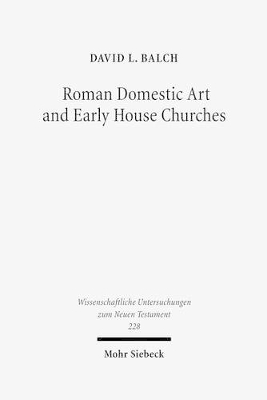Wissenschaftliche Untersuchungen zum Neuen Testament
2 primary works
Book 228
In contrast to most studies of earliest Christianity that focus on texts, David Balch inquires into the visual world of the culture in which early Christians lived and worshipped. Jews and Christians outside Israel lived in Greek and Roman houses and apartment buildings. During earlier Republican and later Imperial periods, artists painted frescoes on the walls of their patrons' houses. Beginning in the mid-1700s, archaeologists began unearthing brilliantly colored domestic paintings, often of Greek (rarely of Roman) myths and tragedies, especially in Pompeii, Herculaneum, and Rome. The author inquires how visual representations seen daily might influence the understanding of Jewish and Christian scriptures read and heard in those same spaces as well as the meaning of rituals performed in domestic worship. Scenes from the tragedies of Euripides as well as visual representations of contemporary gladiatorial games make suffering, sacrifice, and death surprisingly present in Roman houses, themes not first introduced by Christian preaching or the Eucharist. Further, David Balch includes not only recent studies of domestic art, but also of Roman domestic architecture (domus and insulae) by British (Wallace-Hadrill), American (Clarke, Leach), German (Zanker, Dickmann), and Italian (Maiuri, Pappalardo) scholars, studies that affect descriptions of the social history of early Christianity.
Book 345
Ethnic values changed as Imperial Rome expanded, challenging ethnocentric values in Rome itself, as well as in Greece and Judea. Rhetorically, Roman, Greek, and Judean writers who eulogized their cities all claimed they would receive foreigners. Further, Greco-Roman narratives of urban tensions between rich and poor, proud and humble, promoted reconciliation and fellowship between social classes. Luke wrote Acts in this ethnic, economic, political context, narrating Jesus as a founder who changed laws to encourage receiving foreigners, which promoted civic, missionary growth and legitimated interests of the poor and humble. David L. Balch relates Roman art to early Christianity and introduces famous, pre-Roman Corinthian artists. He shows women visually represented as priests, compares Dionysian and Corinthian charismatic speech and argues that larger assemblies of the earliest, Pauline believers "sat" (1 Cor 14.30) in taverns. Also, the author demonstrates that the image of a pregnant woman in Revelation 12 subverts imperial claims to the divine origin of the emperor, before finally suggesting that visual representations by Roman domestic artists of "a category of women who upset expected forms of conduct" (Bergmann) encouraged early Christian women like Thecla, Perpetua and Felicitas to move beyond gender stereotypes of being victims. Balch concludes with two book reviews, one of Nicolas Wiater's book on the Greek biographer and historian Dionysius, who was a model for both Josephus and Luke-Acts, the second of a book by Frederick Brenk on Hellenistic philosophy and mystery religion in relation to earliest Christianity.

